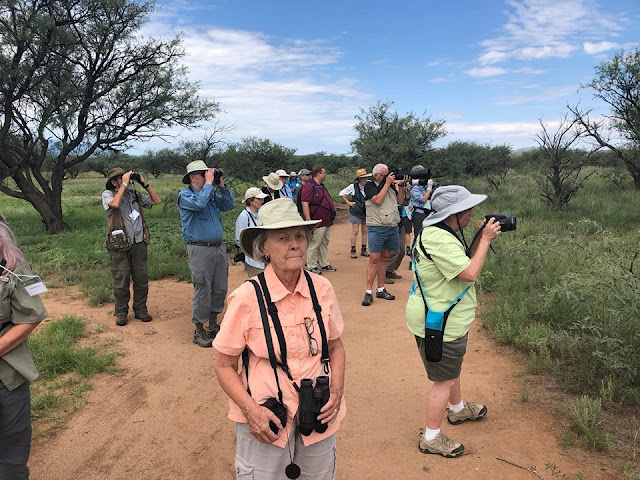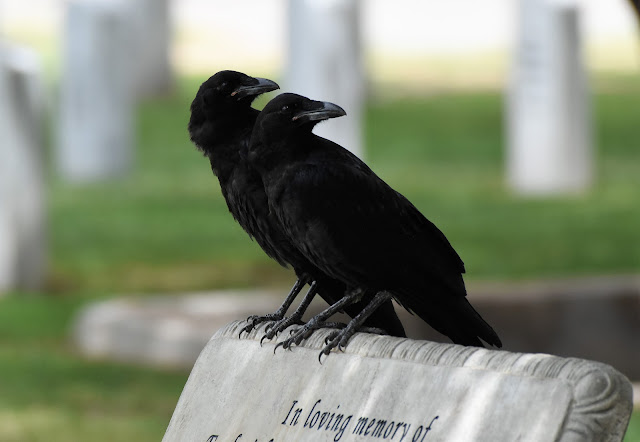 |
| Whiskered Screech-Owl peeks out of a Willow Tree |
 |
| They see their first Sulphur-bellied Flycatchers |
It's hard to transition sometimes from one trek into another. From birding two weeks in Hawaii, I felt what the word extinction really meant. And it hit me hard. You could say I was in a funk. Then I get back to Arizona where life and birds are fun again. Our birds are happy here. There's lots of birds and none are really endangered. Organizations like Tucson Audubon have helped protect Southeastern Arizona from many human disasters. And it continues to do so. So the vibe here is a happy and adventurous one. One could say that birding treks can be very bipolar. Hawaii was my first sad discovery and several friends have warned me that it won't be my last last.
 |
| The Hepatic and Western Tanagers are in good numbers around the canyons |
 |
| Eastern Bluebirds(the Mexican subspecies) breed on the Huachuca base |
 |
| the ancient petroglyphs of Garden Canyon |
 |
| A Gray Hawk played with me. I told the participants one was calling from somewhere in the area. As we were driving out, I caught the bird sitting on the branch! Lifer! Several people very happy:) |
 |
| Western Wood-Pewees continue to nest during this late time of year when other birds begin to migrate south |
 |
| Exhausted after a wonderful morning, it's now time to cool off and head home. |
 |
| One of several Pronghorn seen in the grasslands around Empire Ranch |
 |
| We spy Lazuli Buntings at this cattle tank |
 |
| Lark Buntings are still in their breeding plumage, but several, like the one above, is beginning to transition into winter plumage |
 |
| The crew spots and male and female Elegant Trogon |
 |
| This appears to be a juvenile male Blue Grosbeak as there is some slight blue forming on the plumage |
 |
| We watch a Painted Redstart steal the show |
It's amazing to me how each place has a different feel for birds. I think in Arizona, it's far more accessible for people to come and bird. We have a few quirky things to know like bring water, lock your doors, watch out for poisonous wildlife and watch for quickly changing weather conditions. In Mexico, it was watch your camera. In Trinidad, it was watch your camera and don't go out after midnight because people get murdered. And in Hawaii, it was relax and bird, but with a heart breaking sadness. An international birder has to learn how to go with the flow. When we travel, we discover how locals view their wildlife. And sometimes it sucks.
The two biggies in Arizona that we constantly fight are wildfires and limited water. Human morons are constantly trying to drain the last of our rivers in already bone dry conditions. They are the life blood for much of our wildlife. That's why I support Tucson Audubon and others. This year, our Saguaro cactus seem to be taking a hit with development in areas like Oro Valley. Careless developers destroyed many natural homes for our local Purple Martins, owls and flickers. This year I've lost my colony of Purple Martins at my work site. It was heart breaking. Lightning blew out the cactus and with it, the family of martins. Broke my heart. There is one colony left. Yesterday 12 of them gathered and are now preparing to migrate south.
 |
| Jennie gets the scope ready to view a nesting Violet-crowned Hummingbird! They add lichens to their little tea cup nest. See in ebird report below. |
 |
| The crew ID's Western Kingbirds and a Botteri's Sparrow |
 |
| We end our day happy with many Buff-breasted Flycatchers bouncing around us with their "whits" |
For now, I'll help whenever needed. I much like working with people and helping them find their birds. I am working on new adventures, but have been dealing with painting our place, paying bills, and living a mortal life. October promises to be an exciting one as does November and December. I am 23 lifebirds short of my goal. Where will I go next? Stay tuned for more!
For our adventures, click on the here.
For the Las Cienegas Grasslands, click here.
And for Huachuca Canyon, click here.


























































